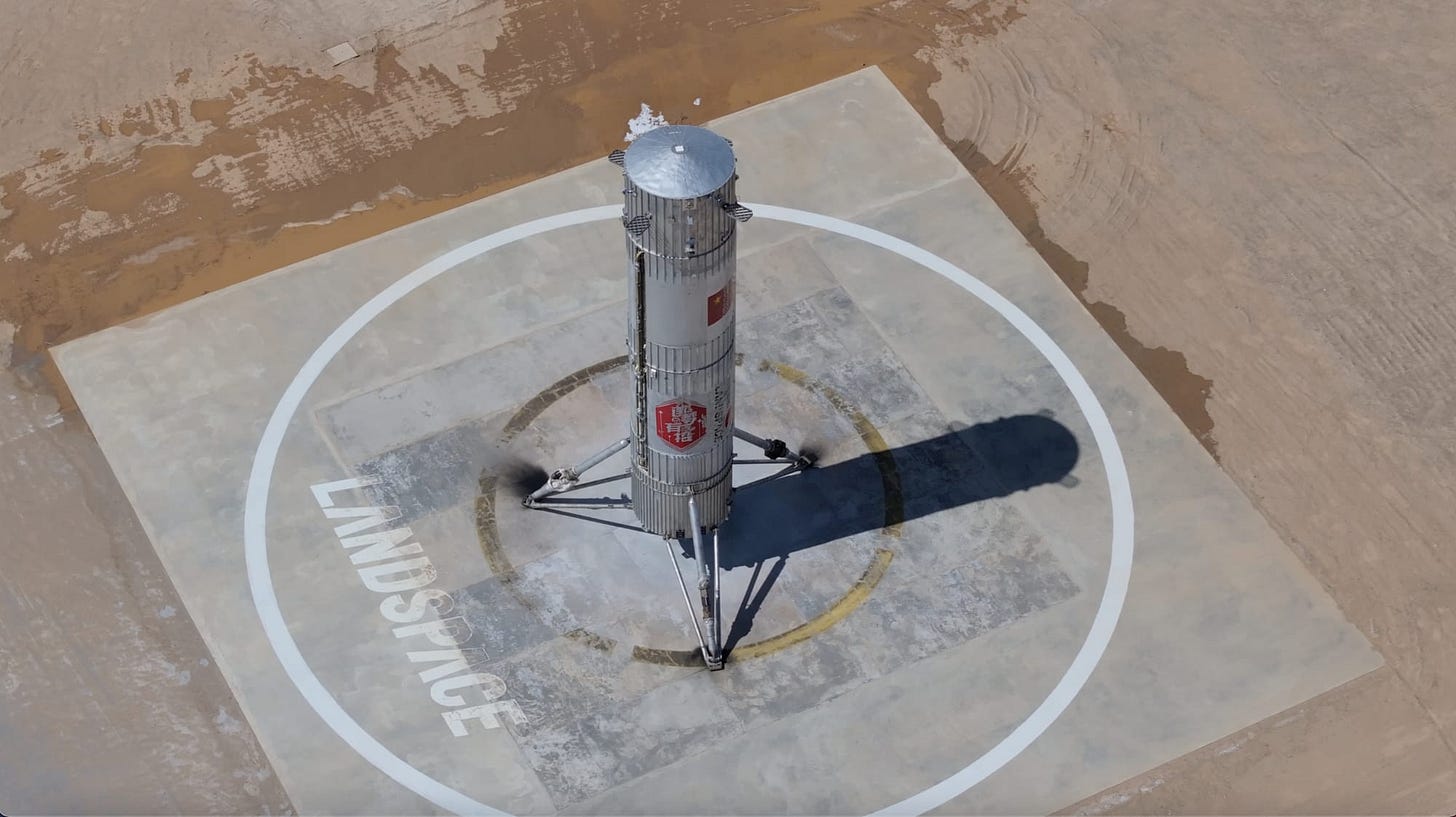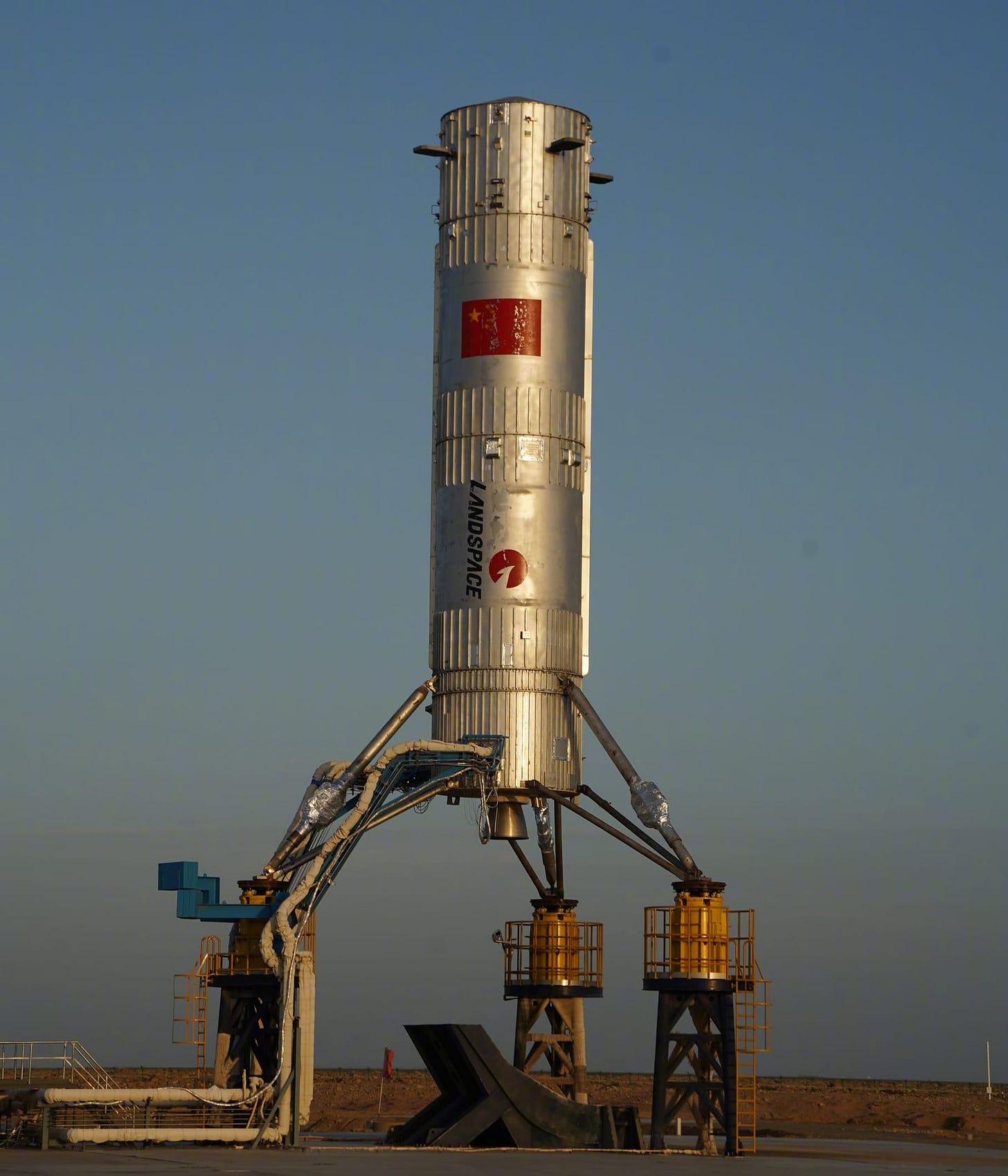LandSpace completes second hop test ahead of Zhuque-3's debut flight
LandSpace recently completed a 10-kilometer hop test in a major first for China's commerical space sector.
LandSpace announced that they had completed a 10-kilometer hop test. The hop test was using the company's Zhuque-3 VTVL-1 vehicle, with it launching and landing inside the Jiuquan Satellite Launch Center on September 11th.
This test was the first time a privately held commercial space company performed a 10-kilometer hop test, with LandSpace beating Deep Blue Aerospace who are also expected to hop soon. It was also the first time a rocket-engine-propelled vehicle has been reused in China, VTVL-1 previously flew back in January for a 350-meter hop test.
Shortly after the test, LandSpace shared a celebratory post on Weibo saying the following:
"This mission is the first time in China to achieve technical verification such as the secondary ignition of vertical take-off and landing return rockets in the air, the joint guidance and control of "grid rudder-cold air attitude control-engine" under transonic high dynamic pressure environment, and the engineering application of high-altitude wind real-time wind repair technology, which indicates that China's commercial aerospace has made a major breakthrough in reusable launch vehicle technology, for the future to achieve large capacity, low cost, high frequency, reusable space launch has taken a key step!"
LandSpace stated that the flight time of the test was 200.7 seconds, 3 minutes & 20.7 seconds. Powered ascent of the vehicle lasted for 113 seconds until the engine was shut down allowing inertia to carry the vehicle to a maximum height of 10,002 meters above the ground.
While passing the peak altitude, the four grid fins and various reaction control thrusters guided the vehicle until the engine relighted at an altitude of 4,640 meters. Powered descent then brought the vehicle down to its landing pad, where it landed 1.7 meters off-center at a speed of 1.65 meters per second, or 3.7 miles per hour (5.95 kilometers per hour).
In a post-test flight blog post on their official WeChat/Weixin account, LandSpace highlighted four areas fulfilled by the test:
Verified the technology for lighting engines in flight in similar conditions to reusable rocket boosters.
Verified the grid fin and reaction control system thruster control system with the landing algorithm at high speed and altitude.
Verified reusability by reflying a stainless steel rocket body, avionics, and engine.
Demonstrated real-time wind correction technology solutions to reduce loads on the vehicle as well as increasing reliability and performance.
With this second test, LandSpace believes they have laid a solid foundation for the first flight and booster landing of Zhuque-3. Zhuque-3 is currently expected to perform its debut flight in 2025, followed by a first booster landing in 2026.
The vehicle that performed this test is what LandSpace is calling Zhuque-3 VTVL-1, VTVL stands for Vertical Take-off Vertical Landing. The engine on the vehicle is a TQ-12A burning liquid methane and liquid oxygen to generate 80 tons of thrust.
As previously mentioned, four grid fins and a series of reaction control thrusters guide and orient the vehicle during unpowered flight. Three fixed legs are also installed to allow for a stable landing.
What is Zhuque-3?
Zhuque-3 is LandSpace's in-development two-stage partially reusable medium to heavy lift launch vehicle. Zhuque-3 plans to burn liquid methane and liquid oxygen propellants in its engines on both stages, which will be built out of stainless steel.
LandSpace claims that Zhuque-3 will be able to lift up to 21,300 kilograms to low Earth orbit when expended, 18,300 kilograms when landing downrange on a drone ship or landing pad, or 12,500 kilograms when returning to the launch site.
The first-stage of Zhuque-3 is planned to be powered by nine TQ-12B engines generating an approximate combined 900 tons of thrust while burning liquid methane and liquid oxygen. LandSpace is also looking to fly each first-stage twenty times, with the potential to certify them for more flights.
The second-stage of Zhuque-3 is planned to be powered by one TQ-15B generating a believed 100 tons of thrust while also burning liquid methane and liquid oxygen.
To facilitate reuse of the first-stage, three engines will be lit during re-entry followed by one being lit again for landing on a drone ship or landing pad. For boost-back burns, the booster will turn around in-flight after separation and relight one engine.
The boosters and second stage are currently planned to have a diameter of 4.5 meters. The fairing is planned to be 5.2 meters in diameter and split into two halves. The total height of Zhuque-3 is currently planned to be 76.6 meters with it having a fully fuelled mass of approximately 660,000 kilograms.
Who is LandSpace?
LandSpace Technology Corporation is a Chinese private space launch provider based in Beijing and founded by Zhang Changwu in 2015.
The company launched its first rocket, Zhuque-1, on the 27th of October 2018 but failed to reach orbit. Zhuque-1 was a three-stage solid propellant rocket that was aiming to lift 300 kilograms into orbit until its cancellation in favor of Zhuque-2, which has so far launched three times with two successes. LandSpace has so far launched all of its rockets from the Jiuquan Satellite Launch Center, located in the Gobi Desert in northern China.
LandSpace is also actively developing Zhuque-3 for a maiden flight planned in 2025.
Now what I didn’t manage to fit into the report for Cosmic Nxws was the wealth of imagery of the hop. As such I’m sharing it here so there is an easy place to find it on the English-speaking, and Western, internet. I’ll also explain what I believe caused the ‘liberation’ of the vehicle’s raceway.
Video from LandSpace, SpaceLens云上天镜, China Central Television, CGTN.
If you’re reading this in your email inbox clicking these videos will redirect you to YouTube.
Imagery from LandSpace.
Raceway ‘liberation’
During the 10-kilometer hop test, the raceway on the side of the Zhuque-3 VTVL-1 vehicle appeared to ‘liberate’ itself from the rest of the vehicle. This raceway covers two gaseous lines that keep the propellant tanks at pressure.
LandSpace uses a similar, and longer, raceway on both stages of its Zhuque-2 launch vehicle. These raceways have been used three times successfully on all of Zhuque-2 flights.
For the hop test, the raceway remained attached during ascent and came free after the engine reignited during descent. As such it likely came free due to a mixture of the descent speed, aerodynamic forces, and vibrations following the beginning of the second engine burn.
Zhuque-3 VTVL-1 is a relatively ‘barebones’ vehicle compared to Zhuque-2, which has insulation and a paint job on the outside of the vehicle. The insulation and paint job likely helps to secure the raceway during flight.
Despite this small hardware issue, LandSpace remains confident about testing reusable rocket technology ahead of its first operational booster landing in 2026.












